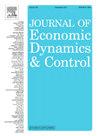Mismatch unemployment during COVID-19 and the post-pandemic labor shortages
IF 2.3
3区 经济学
Q2 ECONOMICS
引用次数: 0
Abstract
We examine the extent to which mismatch unemployment—employment losses relative to an efficient allocation where the planner can costlessly reallocate unemployed workers across sectors to maximize output—shaped labor market dynamics during the COVID-19 pandemic and the subsequent recovery episode characterized by labor shortages. We find that, for the first time in our sample, mismatch unemployment turned negative at the onset of the pandemic. This result suggests that the efficient allocation of job seekers would involve reallocating workers toward longer-tenure and more-productive jobs, even at the expense of fewer hires. We show that sectoral differences in job separations were the main driver behind this result, while differences in vacancies caused positive mismatch unemployment during the recovery episode. We also establish an empirical link between mismatch unemployment and the surge in the labor cost during the recovery, documenting that sectors with larger mismatch unemployment experienced higher employment cost growth.
COVID-19期间的不匹配失业和大流行后的劳动力短缺
在2019冠状病毒病大流行期间和随后以劳动力短缺为特征的复苏时期,计划者可以无成本地将失业工人重新分配到各个部门,以最大限度地提高产出型劳动力市场的动态,我们研究了不匹配失业-就业损失相对于有效配置的程度。我们发现,在我们的样本中,错配失业率首次在疫情开始时变为负值。这一结果表明,求职者的有效分配包括将工人重新分配到更长期和更有生产力的工作上,即使是以减少雇佣为代价。我们发现,离职的行业差异是这一结果背后的主要驱动因素,而空缺的差异在复苏时期导致了正错配失业。我们还在经济复苏期间建立了错配失业与劳动力成本飙升之间的实证联系,记录了错配失业较大的部门经历了更高的就业成本增长。
本文章由计算机程序翻译,如有差异,请以英文原文为准。
求助全文
约1分钟内获得全文
求助全文
来源期刊

Journal of Economic Dynamics & Control
ECONOMICS-
CiteScore
3.10
自引率
10.50%
发文量
199
期刊介绍:
The journal provides an outlet for publication of research concerning all theoretical and empirical aspects of economic dynamics and control as well as the development and use of computational methods in economics and finance. Contributions regarding computational methods may include, but are not restricted to, artificial intelligence, databases, decision support systems, genetic algorithms, modelling languages, neural networks, numerical algorithms for optimization, control and equilibria, parallel computing and qualitative reasoning.
 求助内容:
求助内容: 应助结果提醒方式:
应助结果提醒方式:


